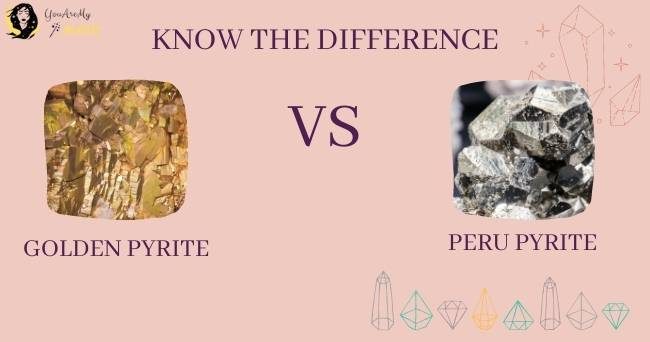“ALL THAT GLITTERS IS NOT GOLD”, this saying fits perfectly in the case of Pyrite or ‘FOOL’S GOLD’.
Gold and Pyrite are both naturally occurring elements.
However, gold is golden to silvery yellow, whereas pyrite is a pale to medium brassy yellow with some tarnishes.
Pyrite and gold deposit can be found embedded in certain rocks, riverbeds, scattered across geological sites.
Polished Pyrite flakes and Gold flakes are visibly similar.
But with a little bit of experience and the methods listed in this article, you will easily be able to identify the difference between REAL GOLD and the FOOL’S GOLD.

What is the difference between Pyrite and Gold?
TARNISH: There will be at least some tarnish on most composites of pyrite encountered in the natural environment.
Gold nuggets or tiny flakes are generally brilliant and tarnish-free.
HUE: Pyrite has a brassy appearance.
A golden to yellow hue characterizes gold. A specimen containing a high enough amount of silver will seem to be whitish-yellow in appearance.
SHAPE: In many cases, pyrite is discovered in angular chunks with faces resembling a cube, octahedron, or pyritohedron. Gold has softer rounded edges.
STRIATIONS: Numerous pyrite crystals are striated throughout the length of their faces, with tiny parallel lines.
As far as I know, there are no striate on gold crystals.
DENSITY: Gold can be easily identified from the mixture of pyrites by evaluating the densities of both using the Panning method.
Gold flakes are relatively denser than pyrite flakes, and hence, are heavier. Gold has a specific gravity of 19.3, while pyrite has just 5.
If the gold bit on your palm is not as heavy as it should be, then you’re probably holding the fool’s gold.
MAGNETISM: Gold being a non – ferrous metal, i.e. being deprived of iron, Gold flakes do not get attracted to a magnet.
While pyrite flakes are rapidly drawn towards the magnet.
BRITTLENESS: Fool’s gold is crucially brittle, i.e. it breaks apart when hammered or put under pressure.
But, gold being the most ductile and malleable metal, bends down instead of breaking into pieces.
HARDNESS: Pyrite’s hardness is somewhat around 6 on the Mohs Hardness scale.
While that of gold is 3 which is an easily distinguishable characteristic.
STREAK: Gold gives a pretty, yellow streak while the fool’s gold having a black hue, displays a black streak.
USES: Gold is extensively used in jewelry and decorative items for its visual appeal.
Pyrite jewelry is not as popular as Gold and Pyrite stone is mainly used for its metaphysical properties.

How to tell Pyrite from Gold?
Gold and Pyrite both have a metallic luster but are different shades of yellow.
Gold is clean with bright yellow shine. Iron Pyrite mineral has a bright brassy or silver luster and may have black iron tarnish.
Pyrite is usually brittle and breaks rather than bends as Gold does
Gold Panning Method to tell Pyrite from Gold
- Take a panning bowl with water and throw in the Gold pieces and Pyrite mixture into it.
- Wash off the excess dust and shake the bowl simultaneously.
- After a while, you would notice some gold particles and some gold-looking flakes.
- The ones that settle down at the bottom of the pan or in between the rifles are the real gold flakes.
- While the shining bits that float on the water and turn pale when seen under shade are fool’s gold.
Why is Pyrite called “Fools Gold”?
Pyrite is also referred to as “fool’s gold” because it was frequently mistaken for the real thing in the past.
This is due to its striking resemblance to raw Gold in color.
Although it looks like Gold, Pyrite is brittle and will break into pieces if it’s bent too much.
Both naturally occurring minerals differ majorly in their properties.

Peru Pyrite vs Golden Pyrite
Peru Pyrite and Golden Pyrites are both varieties of Pyrite with similar metaphysical properties but differ slightly from each other on looks and availability.
Availability:
Peru Pyrite is rare compared to Golden Pyrite hence is more expensive.
Hardness:
Both Pyrites have a hardness of 6 – 6.5 on the Mohs Hardness scale.
Color:
Golden Pyrite has a brassy golden tinge with black portions. Peru Pyrite has a bright silver sheen to it.
Forms:
Golden Pyrite is available in various forms such as pyramid, Angel, Cube, chips while Peru pyrite is only available in cluster form.
Is Pyrite Metallic or Non Metallic?
Pyrite is totally metallic and the properties of metal like Attraction, Repulsion and much more are also applicable to Pyrite.
Does Pyrite stick to a magnet?
Pyrite is an iron sulfide mineral with major iron content in it hence will adhere to a magnet.
If two like poles of two different pyrites are brought together, they will repel against each other.
If two opposite poles of two different pyrites are brought towards each other, they will attract each other.
Conclusion
Both Gold and Pyrite flakes are precious minerals in their own right and can be easily distinguished with some knowledge and practice.

Like many people, I began to search for answers to the deep questions of life, and the meaning of existence.
I sought out answers to “Who am I,” “Why am I here,” and “What was I sent to do?” The answer I found, and continue to find, can be summed up in 2 words: LOVE and LIGHT.
There is love in everything and everyone, and each of us is here to share that love with the world.
I am a spiritual healer and intuitive who has been using my healing gifts to help others.